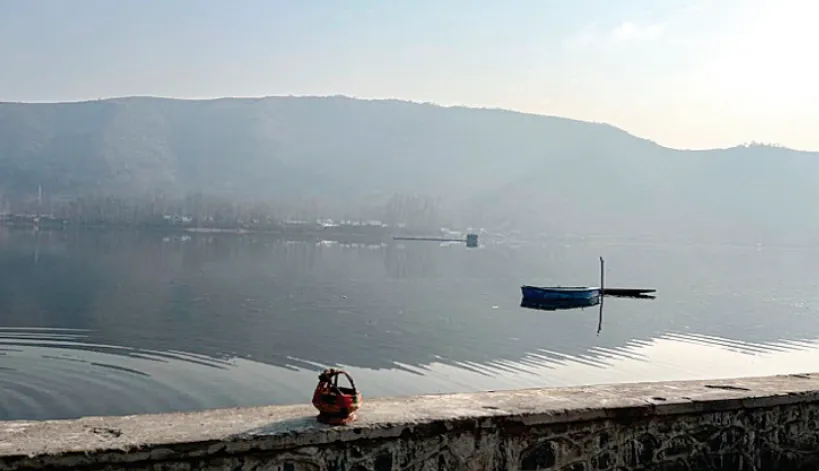Taking advantage of the unprecedentedly warm winter of the valley I decided to go for a visit to the Manasbal lake, a touristic spot I had never visited. I had heard about it only in regards to the lotus stem roots (Nadroo) which according to some are very tasty.
My friend and neighbour Mr Manzoor Nawchoo who had visited it recently also encouraged me for this venture. Incidentally it is one of the least known waterbodies despite its proximity to the city.
Despite this it is considered to be one of the jewels of the beautiful lakes of the valley. Being the peak of winter, the surrounding gardens of this lake wore a deserted bare look with just one family of tourists from Ahmedabad visiting it at that time.
We drove to it going via the Sumbal, Bandipore road reaching the lake via the Jarokabal village on banks of the lake. The other route is from Shadipore, Nasim and Ganderbal on the road to the Wular lake, which is the largest lake of the valley. The lake is located in the Safapora area of the Ganderbal district.
It is an ancient lake according to the locals residing in its vicinity but exact dating is still not known. Adjacent to it, however, are the ruins of a 17th century fort called the Jharokha Bagh fort, built by Nur Jahan the most prominent wife of the Mughal emperor Jahangir.
Another place close to it is the Darogabagh which was used by caravans travelling from Punjab to Srinagar. The name Manasbal is derived from Mansarovar, a well-known highest altitude fresh water lake in Tibet Autonomous Region, China.
The lake is surrounded by four villages: Jarokabal, Kondabal, Nesbal and Gratbal. The Mughal Garden called Jarokabagh overlooks this lake. The locals believe the lake has no bottom. As per the mythology a rishi spent a life time here creating a length of rope to reach its bottom but could not. He eventually threw himself into the water and was submerged in it for eternity.
However, surveys have revealed it to be the deepest lake of the valley with a depth of 13 meters (43 feet). The waters of the lake are serene, calm and placid. In summer the lotus blooms add to its beauty. The rootstocks of lotus plants (Nadroo in Kashmiri) which grow extensively in it are harvested and marketed besides being consumed by the local people. A Kashmiri kitchen without a nadroo is unimaginable.
The drainage basin for the lake, covering an area of 10 sq km has no major inlet channels and thus is fed by precipitation (rain and snowfall) and springs (more than 1200 springs). The excess water from it flows into Jhelum River through a regulated outflow channel.
It is a source of water for fishing and for obtaining food. A number of varieties of fish had been introduced in the lake. Cyprinus an exotic species has proliferated extensively after its introduction in 1956. In fact, fish bought from this lake is considered a delicacy and is often cooked with the lotus stems (nadroo) in the form of a highly spiced curry.
The lake is surrounded by a number of majestic hills, the Baladar mountains on the east and an elevated plateau known as Karewa on the North and Ahtung hills in the South. These hills are rich in limestone which is dug out as an industry.
Aquatic birds gather in this lake towards the spring (March to end of May) making it a paradise for bird watchers who throng the banks of the lake and also go in boats. Walking around the lake along the path built surrounding it is a pleasure.
Many families come and enjoy picnicking here. Recently water skiing is another activity to keep oneself busy and engaged. The lake also has facility for Shikara riding which can be availed of by three to four persons, as in the Dal Lake, a counterpart of Venice’s Gondolas.
The area has a rich historical past, with ruins of temples dated 800 or 900 A D, having been excavated. These were constructed in grey stone in the Kashmiri architectural style. There are also remnants of Buddhist shrines on the shore. These are reminders of the ancient rules of Kashmir as mentioned in the Rajatarangini, a historical chronicle of the kings of Kashmir.
Unfortunately, due to increasing population, encroachment and disposal of waste into the lake as in the case of other lakes of the valley an explosive growth of micro-organisms (eutrophication) has been recorded and confirmed by scientific tests.
A variety of poisonous weeds in the form of dense non-specific strands have been created by these. This has resulted in a marked decrease in the species diversity of this beautiful lake. Pollution due to lack of waste water treatment plants has added to this problem. These findings were noted by the World-Wide Fund for Nature (WWF) way back in 1997.
In view of this a lake restoration work was started in the year 2007 with the formation of Wular-Manasbal Development Authority by then Chief Minister, Mr Ghulam Nabi Azad, with the removal of illegal constructions, de-weeding and dredging and regulation of limestone extraction. A pedestrian pathway around the lake periphery of 11 Kms was also built.
This, however, took lot of deliberations with locals before the work could be started. The conservation and restoration of Manasbal was imperative not only for promotion of tourism but also for improving the livelihood of the local population.
The present administration has continued the work in that area and completed a mega project under the Manasbal-Bandipore Gurez Sopore route at a cost of around Rs 500 crores recently.
It is hoped that Manasbal lake would continue to enamour us and becomes a very sought after tourism facility with a good touristic infrastructure around it keeping the ecology of the place in good shape. This would also benefit the local population of this beautiful area.
Prof Upendra Kaul, Founder Director Gauri Kaul Foundation







